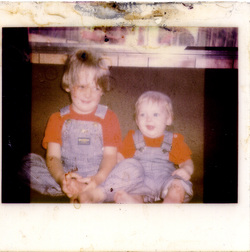A few weeks ago, a colleague of mine was lamenting that she had a damaged photo, and that she could not find anyone to restore it. One of the people she was talking to suggested talking to me, and I found myself taking on a new and interesting project.
Usually I like to suggest locations for photographs, or talk about how to get that special shot, but sometimes the work you put into a photo after the fact is just as important. That being said, I believe that the more careful you are creating and composing your original shot the better the quality and the less post production you need to do. For the most part I use Lightroom for a bit of white balance correction, perhaps a bit of crop. If I think the exposure is a bit off, I might play by a stop or two. I can do the basic functions, and I have fun fiddling with the levels (sometimes with surprisingly neat results), but Photoshop is not a strength of mine by any means. When she asked me to take a look at the damaged photo, I was a little hesitant but also excited to try out old tools in a new way.
The first thing I have to note about taking on a restoration project, however, is to be completely frank about your expectations. I was up front and said I would give it a shot, but could not guarantee the final output quality. Thanks to Photoshop, Even if you're attempting to restore a photo for the first time, at least there's no chance of harming the original.
Usually I like to suggest locations for photographs, or talk about how to get that special shot, but sometimes the work you put into a photo after the fact is just as important. That being said, I believe that the more careful you are creating and composing your original shot the better the quality and the less post production you need to do. For the most part I use Lightroom for a bit of white balance correction, perhaps a bit of crop. If I think the exposure is a bit off, I might play by a stop or two. I can do the basic functions, and I have fun fiddling with the levels (sometimes with surprisingly neat results), but Photoshop is not a strength of mine by any means. When she asked me to take a look at the damaged photo, I was a little hesitant but also excited to try out old tools in a new way.
The first thing I have to note about taking on a restoration project, however, is to be completely frank about your expectations. I was up front and said I would give it a shot, but could not guarantee the final output quality. Thanks to Photoshop, Even if you're attempting to restore a photo for the first time, at least there's no chance of harming the original.

A few days after accepting the job, this is the photo I received.
This is a Polaroid photo of her children who I believe are in their early 30s now, making this Polaroid over 25 years old. It is sun-bleached, where it sat in some sort of frame, and has burn holes and stains embedded into it. As soon as I saw it, I understood why no other restoration place was willing to take this on, but because of the working relationship I had with the client, and since I'd already stressed to her that there were no promises about the result, I thought I would give it a whirl.
The first thing I did is scan at 2400 DPI (the highest setting on my scanner) to create as much information on the photo as I could and smooth out some grain, then the work began. I did a quick crop to get rid of the boarders, including the darker sides, did a lot of colour correction and dodge and burn to change exposure in specific areas. Finally, I super enlarged the photo to use the clone tool to "heal" some areas by replacing damaged areas with a similar colour from nearby healthy areas on a pixel by pixel basis.

This image was the result. Not so bad, now, is it?
I am sure there are Photoshop artists out there who could have re-conditioned the entire photo, but even though this way is not perfect, it still has that early 70s Polaroid.
Scanning the original at such a high resolution and healing with a pixel by pixel process also meant that I was able to enlarge the original, so the client was able to print out a larger version as a 4x5.
After delivery, the owner of the photo was in tears. She couldn't believe that the photo, which was so dear to her, was brought back to this type of quality. I didn't have the heart to tell her the reason no other photo refinisher/restorer would touch it was because she wouldn't have wanted to pay for the nearly 14 hours of work that this photo took; it probably would have cost her several hundred dollars.
But part of being a part-time photo geek means that I have the time to fool around with projects like this when it suits me, without worrying about putting bread on the table. This project does give a good example of how much you can do in restoration work.
Do you have a restoration project you would like to share? Leave a link in the comments below! I would love to see what others are up to and maybe offer some tips and tricks for specific projects if you're stumped about something.
But part of being a part-time photo geek means that I have the time to fool around with projects like this when it suits me, without worrying about putting bread on the table. This project does give a good example of how much you can do in restoration work.
Do you have a restoration project you would like to share? Leave a link in the comments below! I would love to see what others are up to and maybe offer some tips and tricks for specific projects if you're stumped about something.

 RSS Feed
RSS Feed
